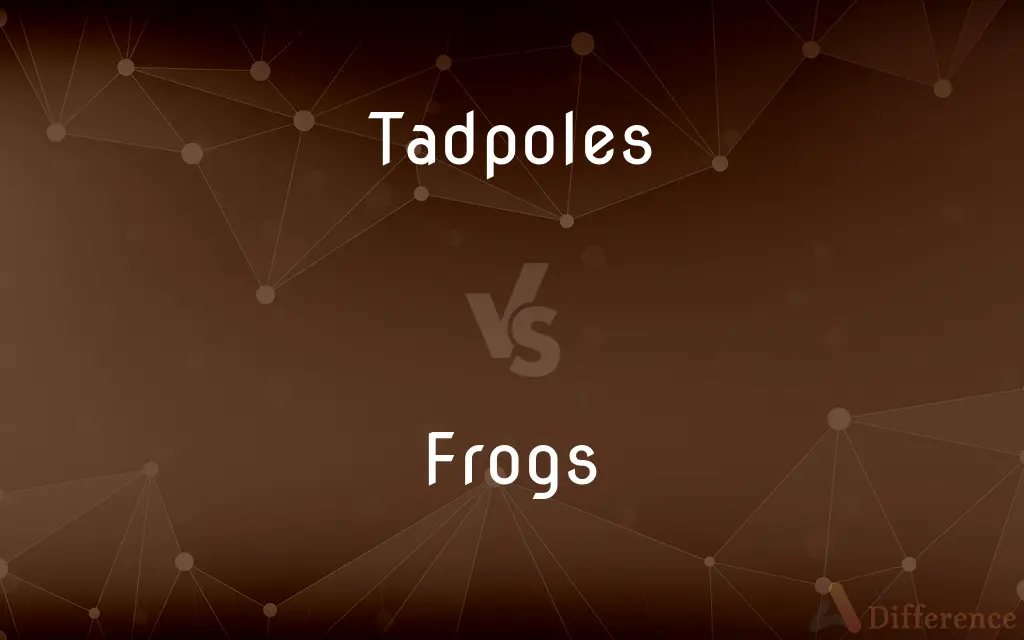Tadpoles vs. Frogs — What's the Difference?
Edited by Tayyaba Rehman — By Fiza Rafique — Published on December 24, 2023
Tadpoles are the aquatic larval stage of amphibians, primarily frogs; frogs are the mature, typically terrestrial form.

Difference Between Tadpoles and Frogs
Table of Contents
ADVERTISEMENT
Key Differences
Tadpoles and frogs represent two distinct life stages of the same amphibian organism. Tadpoles are the initial aquatic phase, born after the frog's eggs hatch. They reside mostly in water and rely on gills to breathe. Frogs, on the other hand, are the mature phase of these creatures, developed after metamorphosis.
Tadpoles have a tail and lack limbs at the beginning of their life. As they grow, they gradually develop hind legs and then forelegs. Frogs, however, possess fully developed legs which they use for hopping and climbing, and they lack the tail characteristic of tadpoles.
Tadpoles primarily consume plant matter like algae, using their herbivorous mouthparts. Frogs, in contrast, are generally carnivorous, feeding on insects, worms, and sometimes even small fish or other creatures, utilizing their wider mouths and long, sticky tongues.
Tadpoles have smooth, slimy skin that's adapted for their aquatic lifestyle. Frogs, depending on the species, might have smooth, warty, or bumpy skin, usually more adapted to a terrestrial or amphibious existence.
The transformation from tadpoles to frogs is a remarkable metamorphosis process. Tadpoles undergo significant physiological changes, like the development of lungs for breathing air, to transition into the frog form, indicating the fascinating adaptability of these creatures.
ADVERTISEMENT
Comparison Chart
Stage of Life
Larval phase
Mature phase
Physical Traits
Tail, initially no limbs
Fully developed legs, no tail
Habitat
Primarily aquatic
Terrestrial or amphibious
Diet
Mostly herbivorous (e.g., algae)
Carnivorous (e.g., insects, small animals)
Breathing
Gills
Lungs
Compare with Definitions
Tadpoles
Tadpoles are the larval stage of amphibians.
The pond was teeming with tiny tadpoles.
Frogs
Frogs possess lungs and breathe air, but they can also absorb oxygen through their skin.
The frogs sat near the water's edge, their chests rising and falling with each breath.
Tadpoles
Tadpoles have tails and lack legs in their early stages.
I observed the tadpoles wriggling their tails in the water.
Frogs
Frogs have a varied range of vocalizations, often used to attract mates.
The chorus of frogs croaking filled the nighttime air.
Tadpoles
Tadpoles primarily reside in water during their development.
The tadpoles swam swiftly when they sensed danger.
Frogs
Frogs result from the metamorphosis of tadpoles.
After weeks of observation, the tadpoles had transformed into young frogs.
Tadpoles
Tadpoles primarily feed on algae and other plant materials.
The tadpoles grazed on the algae-covered rocks.
Frogs
Any of numerous tailless aquatic, semiaquatic, or terrestrial amphibians of the order Anura, characteristically having a short vertebral column, a large head, long hind legs used for leaping, and a tadpole stage as larvae.
Tadpoles
Tadpoles undergo metamorphosis to become frogs.
The tadpoles began to sprout hind legs, indicating the start of their metamorphic journey.
Frogs
Any of various usually aquatic members of this order having smoother skin and longer hind legs than the toads.
Tadpoles
The aquatic larva of a frog or toad, having gills, a long, laterally compressed tail, and in early stages, no limbs. During metamorphosis of a tadpole into an adult, legs and lungs develop, and the tail gradually disappears. Also called polliwog.
Frogs
A wedge-shaped, horny prominence in the sole of a horse's hoof.
Tadpoles
Plural of tadpole
Frogs
A loop fastened to a belt to hold a tool or weapon.
Frogs
An ornamental looped braid or cord with a button or knot for fastening the front of a garment.
Frogs
A device on intersecting railroad tracks that permits wheels to cross the junction.
Frogs
A spiked or perforated device used to support stems in a flower arrangement.
Frogs
The nut of a violin bow.
Frogs
(Informal)Hoarseness or phlegm in the throat.
Frogs
Offensive Slang Used as a disparaging term for a person of French birth or descent.
Frogs
Plural of frog
Frogs
A decorative loop of braid or cord
Frogs
Frogs are tailless amphibians with strong, jumping legs.
The frogs leaped into the pond with a splash.
Frogs
Frogs are primarily carnivorous, preying on insects and other small creatures.
The frogs waited patiently before snagging flying insects with their sticky tongues.
Common Curiosities
What are tadpoles?
Tadpoles are the aquatic larval stage of amphibians, primarily frogs.
What do tadpoles eat?
Tadpoles primarily consume algae and other plant materials.
How do tadpoles breathe?
Tadpoles breathe using gills when they're in their aquatic phase.
When do tadpoles become frogs?
Tadpoles become frogs after undergoing a process called metamorphosis.
Do tadpoles have legs?
Tadpoles initially lack legs but develop them as they approach metamorphosis.
Where do frogs live?
Frogs can live in a variety of habitats, including ponds, forests, and grasslands, depending on the species.
Can frogs live away from water?
While frogs need water for reproduction, many species can live away from water, especially after the tadpole stage.
Do frogs have tails?
No, frogs do not have tails, unlike their tadpole stage.
Are all tadpoles destined to become frogs?
Most tadpoles will undergo metamorphosis to become frogs, but some might be eaten by predators or face other threats before maturing.
What are frogs?
Frogs are tailless amphibians that are the mature form of tadpoles.
What do frogs eat?
Frogs are primarily carnivorous, eating insects, worms, and sometimes even small animals.
Do frogs have teeth?
Yes, many frog species have small teeth, primarily used to hold onto prey.
Why are frogs important to ecosystems?
Frogs play crucial roles in ecosystems as both predators and prey, and they're also indicators of environmental health.
How do frogs reproduce?
Frogs lay eggs in water, which hatch into tadpoles.
How do frogs breathe?
Frogs breathe using lungs, but they can also absorb oxygen through their skin.
Share Your Discovery

Previous Comparison
Redken Extreme vs. Redken All Soft
Next Comparison
Run Down vs. Run OverAuthor Spotlight
Written by
Fiza RafiqueFiza Rafique is a skilled content writer at AskDifference.com, where she meticulously refines and enhances written pieces. Drawing from her vast editorial expertise, Fiza ensures clarity, accuracy, and precision in every article. Passionate about language, she continually seeks to elevate the quality of content for readers worldwide.
Edited by
Tayyaba RehmanTayyaba Rehman is a distinguished writer, currently serving as a primary contributor to askdifference.com. As a researcher in semantics and etymology, Tayyaba's passion for the complexity of languages and their distinctions has found a perfect home on the platform. Tayyaba delves into the intricacies of language, distinguishing between commonly confused words and phrases, thereby providing clarity for readers worldwide.











































